| Time Period | Qin Dynasty |
| Geographical Region | Realm of Qin |
| List of Symbols |
|
Firstly, I used the map of the Realm of Qin as the background. The shaded line implies the border of the continent. The simple lines inside the realm are the main rivers flowing through. The lines with squares in the north indicate the Great Wall. The triangle-like figures in the southwest imply mountains, because that part was the Province of Tibet (in modern time). Beyond the Great Wall are some symbols looking like grass, and those indicate the steppe. The horse and the bow above its back implies the “barbarians”, or in another word, the nomads. They are famous for their horse and horse archery, that why I used those two symbols. And they were stopped by the Great Wall, so they cannot go any further to the south.
The big, black hat in the middle of the map is the “Jiuliu Mian”. It is a “mian”, which can be roughly translate as “crown”, attached by “Jiuliu” on each side, which can be roughly translate as “nine (jiu) pearl strings (liu)”. Actually the kind of hat with pearl strings is widely use in Qin and Han dynasty for royal court officers and nobles. But only the Emperor can use the hat with nine strings, because the number “nine” has a dignified meaning and always relate to the emperor. I drew that hat really big and put it in the center of the map to imply the dominance of the first and the only emperor at the time: the Qin Shi huangdi, Ying Zheng. He defeated all the other six kings in the Warring States and complete the first unification of China in the history.
Those two soldier are the symbol of Qin soldiers. Their armor is similar to those discovered on terra-cotta soldiers which were excavated at the tomb of Qin Shi huangdi, so this armor could indicate their identities. I did not drew their lower body because there is no armor or other significant clothing there so we will not receive any necessary information from their pants. And their hairstyle is a common hairstyle for the Qin soldier. The long weapon on the left is “ge”. That was a well-known melee pole arm used in Zhou, Qin and even the Han dynasty. Its structure is just like a spear attached with a side blade. And this kind of weapon became “ji”, or in another word, the halberd in the later time. The weapon on the left is a crossbow, a symbolic ranged weapon of the Qin army. According to the record, when Qin army engages an enemy in the battlefield they usually attack with the crossbow squad first to “deteriorate enemy’s morale”. So that why the crossbow became a symbol of the Qin military force.
Those three measuring tools are the symbols of three measurement: length (“du”), capacity (“liang”) and weight (“heng”). And these three things together indicate one of the feats of Qin Shi huangdi: Unification of measurement. He banned all those different measuring system existed in different region during the Warring State period and created a new and the only one. Those coins showed on the right and those Chinese characters at the right bottom corner has the similar meanings: Those coins are the ones used by the other region during the Warring state, and after Qin established the only legal currency is the single one which showed under them—bronze, a round shape with a square hole in the center. Those Chinese characters at the right bottom corner showed how the writing is unified into the Qin Zhuanshu. And actually all these seven character has the same meaning: horse (“ma”).

TIANYAO ZHAO is a Chinese undergraduate student majors in BME in the University of Rochester. He likes to play bamboo flute in spare times. More by Tianyao
